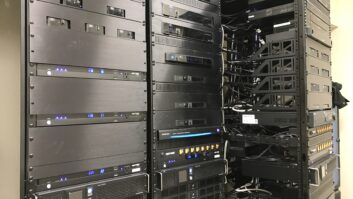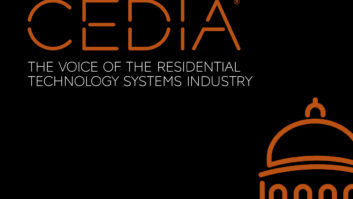After Years of Outsourcing, ESCs are Finally Embracing the Revenue Potential of Security


During a recession, “security” is a word with many possible connotations, but its most literal one may be music to the ears for many electronic systems integrators. While the recession has cut into overall installation sales, which dropped another nearly 10 percent last year, according to a Parks Associates survey, ESCs have nonetheless sensed an opportunity.
Bjorn McGillan, owner of Wire Master Audio Video in Eden Prairie, Minnesota, has switched from hiring subcontractors for his security systems installations to using his own crews for that work. He says the move was prompted by a need for more revenue streams to offset declines in business due to the housing slump.
“When you think about it, since the security system can be integrated into the larger home automation system, it makes perfect sense,” he said.
In addition to income from the security system installation, recurring revenue from monitoring services—something that many AV integrators ceded to the alarm specialists they once partnered with—adds to the allure. More integrators are offering monitoring services directly, subcontracted among scores of regional and national monitoring companies. Most integrator-marketed monitoring costs clients from the $25 range on up to lower $30s per month (based on data from Parks Associates and security industry trade magazine Security Sales & Integration) that the integrator often splits with the service provider. Because as much as 75 percent of the industry’s $9 billion 2010 estimated annual revenue come from monitoring services, this ongoing revenue stream not only brings in cash after the systems installations are done but also adds significant value to AV businesses.
“If I were to put the company up for sale, any buyer would look for the recurring value,” said Rick Gaskell, president of Cobalt Automation in Durango, Colorado, who derives 30 percent of his income from security systems. “A home theater might be $20,000 and a home security system less than $5,000, but with the home theater all I get after that is the chance to bid on another one. With the security system, I get ongoing revenue from the monitoring service.”
The Wild Wild West

ESCs moving into security systems can expect to encounter more oversight than they’re used to on the jobs they do. Regulations for security systems integrators and installers vary from state to state, but many are specific to the sector, such as Sections 326B.31 to 326B.399 of Minnesota’s Electrical Act, which states that “employees of a licensed electrical or technology systems contractor or other employer where provided with supervision by a master electrician…are not required to hold a license… for the planning, laying out, installing, altering, and repairing of technology circuits or systems except [emphasis added] planning, laying out, or installing… circuits that interconnect… through communication, alarm, and security systems…”
Some states have virtually no specific licensing requirements for security systems integrators. John Oliver, owner of Complete Home Electronics in Fraser, Colorado, describes his state as “the wild, wild west” in terms of regulation. But integrators planning to cross state lines to expand their business need to be aware of any regulation in neighboring states. That’s what Cobalt Automation’s Rick Gaskell discovered. He will have to wade through the unfamiliar paperwork when he applies for security systems licensing in New Mexico this year, where Cobalt will need a state-wide security installer license and apply for business licenses on a county-by-county basis. “It’s definitely different from Colorado,” he said.


Reflecting the CEDIA channel’s newfound interest in security integration, distributor AVAD has expanded its product offerings to include security products from manufacturers and service providers including DSC, PSA Security Network, and C.O.P.S. Monitoring. AVAD’s Experience Centers, including this Fort Lauderdale branch, feature fully stocked and integrated security demos. License to Train
Residential ESCs have been pretty much on their own when it comes to learning the ropes about security systems licensing and related matters. But acknowledging the surge in AV integrators incorporating security services in their repertoire, CEDIA and the Electronic Security Association (ESA, formerly the National Burglar & Fire Alarm Association) will for the first time offer training at each other’s trade shows this year. It’s intended to extend the foundational training that the ESA offers through approximately 300 classes it holds nationally each year to create a base for and supplement the manufacturer-centric training that comprises most of the field’s education regimen.
But unlike CEDIA’s training programs, ESA is limited to the basics because of the patchwork of regulations that affect security systems installation.
“CEDIA has a very definable training package that manufacturers were able to buy into comfortably because [AV integration] is not an excessively regulated business,” explained Dale R. Eller, director of education and standards at ESA’s Erie, Pennsylvania, national training base. “But security is the other side of the coin—heavily regulated with no consistency from state to state or even county to county and virtually no reciprocity between them.”
As an example of the disparity between the 40 or so states that regulate security systems installations, Eller cited the New York tri-state area, where New York regulations would permit an integrator from New Jersey or Connecticut to work in the Empire State only if they took their security systems training with a New York state-approved instructor at a New York-approved training venue. Or they could go to nearby Pennsylvania where the state does not regulate the business but where major metropolitan areas, like Philadelphia and Pittsburgh, do.
Eller says that there have been a few attempts to create some national cohesion for security installation regulations. The Central Station Alarm Association, a trade group representing alarm system monitoring companies, has lobbied for licensing reciprocity across state lines. But the Byzantine levels of requirements imposed by states and local jurisdictions argue against that. For instance, in New York each company must have one “qualifying agent” who has been certified and vetted by the state and under whom other employees can be supervised, while New Jersey requires the company to be the licensee while each employee working security must undergo individual training and background checking.”

Bjorn McGillan, owner of Wire Master Audio Video, switched from using subcontractors for his security systems installations to using his own crews for that work. Targeting Upscale Homeowners
The red tape appears to be worth it to a growing number of integrators integrating security into their residential AV projects. Most CEDIA-level companies that offer security services are differentiating themselves from the increasingly aggressively marketed entry-level products offered by companies like ADT by targeting upscale homeowners and custom homebuilders.
Complete Home Electronics’ John Oliver said that integrating advanced security systems with cameras and options like remote viewing with home automation systems adds 10 to 15 percent more to the overall cost of the project. He recently completed a home with more than 60 contact points.
“The [mass-market] security companies can’t compete with that,” agreed Russ Pritchard, owner of The Audio Warehouse in Charleston, South Carolina. He added that theft deterrence isn’t the primary motivation for homeowners adding security to their automation systems, however. “They’re more concerned with the house’s environment—is there a water leak happening?” he explained. “That’s an opportunity to point out to them the larger insurance discounts they can get from the system.”
Entering the security market also paves the way for even more sophisticated systems that include home network systems monitoring. “I could tell my customers when and where their networks are getting congested and add bandwidth, or what life a projector bulb has remaining and replace it before it fails,” Gaskell said. “There are a lot of things that fall under the term ‘security.’”


Visonic has widened its PowerMax control panels line to give integrators more options to compete with high-volume security companies like ADT The Manufacturer’s Perspective
Manufacturers and distributors have noticed the trend toward CEDIA channel acceptance of security integration and have created nuanced responses. Wireless systems manufacturer Visonic, for instance, has widened its PowerMax control panels line to give integrators more options at the lower end of their spectrum, so they can remain competitive with highvolume security companies like ADT , which has stepped up it marketing to more affluent potential clients.
Distributor AVAD has expanded its product offerings to include security products, from manufacturers and service providers including PSA Security Network, DS C, and C.O.P.S. Monitoring. It’s now also offering training on those products as well as assistance on how to install, market, and sell security. AVAD ’s 26 U.S. branches will also offer some guidance for getting state and local certification.
On the other hand, some traditional AV channel manufacturers have realized that the current is moving in both directions. Lutron announced earlier this year that it had joined the Electronic Security Association. The company’s residential sales director Rich Matthews says the synergy was already in place. “The security systems installer is already in the house and is a trusted entity to the homeowner,” he says. “Since lighting is an important part of security systems, adding lighting control to the home is an opportunity for them to add revenue to a project.” But, he adds, the decision also reflects the changed reality of the market. “We did a training session at CEDIA last year and there were 145 people in the room, all AV systems installers,” he recalled. “I asked them… if they also installed security systems and half the room raised their hands. Security and AV installers are beginning to look like each other; the lines are blurring. They’re all becoming multi-systems integrators.”
Fire Safety in MDUs

Jared Lewis has found that integrating fire alarm systems in condos is big business.
Multiple dwelling units (MD Us) are fertile ground for AV integrators also doing security systems. While new construction of condo and apartment buildings remains slack, many older buildings are being required to update their fire alarm systems to meet newly revised codes. This has the potential to be a huge new business sector for AV integrators, if they can act on it.
Jared Lewis, president of Audio Video Excellence (AVX) in Birmingham, Alabama, has done just that. After re-entering the security field during the recession, he discovered a wave of condominiums in his area that are being compelled to add or update fire alarm systems. “We have relationships with condo association boards where we have done AV work before, so we’re already approved vendors,” he said. AVX is currently working on a 120-unit MD U condo where the value of the fire alarm system alone is approaching a half-million dollars. “The conversation starts with AV, moves to the fire alarm system and can lead to things like adding Wi-Fi for the entire building,” he said.







